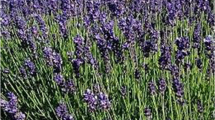Abstract
A perennial plant Nepeta multifida L. (syn. Schizonepeta multifida (L.) Briq.) is one of the most common species of the Lamiaceae family growing in Eastern Siberia and used in traditional oriental medicine. The chemical composition of N. multifida has not been sufficiently studied. Chromatographic separation of phenolic compounds of N. multifida leaves using column chromatography and preparative HPLC made it possible to isolate 16 compounds, including a new flavonoid identified as luteolin-7-O-(3″,6″-di-O-acetyl)-β-D-glucopyranoside, according to UV, NMR spectroscopy and mass spectrometry. Known compounds were luteolin and apigenin O-glycosides, rosmarinic acid, salvianolic acids A and B, and schizotenuin A. Quantitative analysis of N. multifida leaves in various phases of plant development by HPLC-UV assay showed the high content of rosmarinic acid (8.36–35.71 mg/g), luteolin-7-O-glucuronide (2.03–14.18 mg/g) and schizotenuin A (5.29–9.56 mg/g). The highest level of phenolic compounds was found in the flowering and fruiting phases. Using Ellman’s spectrophotometric method, it was found that N. multifida leaf extract and some compounds had antiacetylcholinesterase activity and luteolin glycosides being the most active showed the level of concentration of half-maximal enzyme inhibition (IC50) 29.03– 58.36 μg/mL. Thus, as a result of the present study, it was found that the leaves of N. multifida contain various groups of phenolic compounds capable of inhibiting the activity of acetylcholinesterase.



Similar content being viewed by others
DATA AVAILABILITY
The data that support the findings of this study are available from the corresponding author upon reasonable request.
REFERENCES
Amirzargar, N., Heidari-Soureshjani, S., Yang, Q., Abbaszadeh, S., and Khaksarian, M., Nat. Prod. J., 2020, vol. 10, pp. 550–565. https://doi.org/10.2174/2210315509666190820103658
Pineda-Ramírez, N., Calzada, F., Alquisiras-Burgos, I., Medina-Campos, O.N., Pedraza-Chaverri, J., OrtizPlata, A., Pinzón Estrada, E., Torres, I., and Aguilera, P., Antioxidants, 2020, vol. 9, 253. https://doi.org/10.3390/antiox9030253
Hanafy, D.M., Prenzler, P.D., Burrows, G.E., Gurusinghe, S., Thejer, B.M., Obied, H.K., and Hill, R.A., Nutrients, 2020, vol. 12, Article ID: 1366. https://doi.org/10.3390/nu12051366
Topcu, G. and Kusman, T., Bezmialem Sci., 2014, vol. 1, pp. 1–25. https://doi.org/10.14235/bs.2014.233
Sharma, A., Cooper, R., Bhardwaj, G., and Cannoo, D.S., J. Ethnopharmacol., 2021, vol. 268, Article ID: 113679. https://doi.org/10.1016/j.jep.2020.113679
Flora of Siberia. Pyrolaceae-Lamiaceae, Ed. Malyshev, L.I. CRC Press: Boca-Raton, USA, 2006, vol. 11, 310 p.
Flora of Central Siberia, Ed. Malyshev, Z.D. and Peshkova, G.A. Novosibirsk, 1979, 536 p.
Liu, Z.L., Chu, S.S., and Jiang, G.H., J. Sci. Food Agricult., 2011, vol. 91, pp. 905–909. https://doi.org/10.1002/jsfa.4263
Liu, J.-T., Yu, J.-C., Jiang, H.-M., Zhang, L.-Y., Zhao, X.-J., and Fan, S.-D., Chin. J. Chem., 2008, vol. 26, pp. 1129–1132. https://doi.org/10.1002/cjoc.200890201
Olennikov, D.N., Chem. Nat. Comp., 2021, vol. 57, pp. 818–822. https://doi.org/10.1007/s10600-021-03488-7
Kashchenko, N.I. and Olennikov, D.N., Chem. Nat. Comp., 2022, vol. 58, pp. 274–278. https://doi.org/10.1007/s10600-022-03658-1
Batorova, S.M., Yakovlev, G.P., and Aseyeva, T.A., Reference Book of Medicinal Plants of Traditional Tibetan Medicine, Novosibirsk, 2013, 293 p.
Razuvayeva, Ya.G., Kharzheyev, D.V., Toropova, A.A., and Olennikov, D.N., Voprosy Biologicheskoy, Meditsinskoy i Farmatsevticheskoy Khimii, 2018, vol. 21, pp. 5–10. https://doi.org/10.29296/25877313-2018-07-02
Razuvaeva, Y.G., Toropova, A.A., Olennikov, D.N., and Kharzheev, D.V., Nat. Prod. Rep., 2021, vol. 36, pp. 3105–3109. https://doi.org/10.1080/14786419.2021.1935932
Olennikov, D.N., Nikolaev, V.M., and Chirikova, N.K., Antioxidants, 2021, vol. 10, Article ID: 863. https://doi.org/10.3390/antiox10060863
Malikov, V.M. and Yuldashev, M.P., Chem. Nat. Comp., 2002, vol. 38, pp. 358–406. https://doi.org/10.1023/A:1021638411150
Mizuno, M., Kato, M., Iinuma, M., Tanaka, T., Kimura, A., Ohashi, H., and Sakai, H., Phytochemistry, 1987, vol. 26, pp. 2418–2420. https://doi.org/10.1016/S0031-9422(00)84739-1
Matsuta, M., Kanita, R., Saito, Y., and Yamashita, A., Nat. Med., 1996, vol. 50, pp. 204–211.
Olennikov, D.N., Chirikova, N.K., Kashchenko, N.I., Nikolaev, V.M., Kim, S.-W., and Vennos, C., Front. Pharmacol., 2018, vol. 9, Article ID: 756. https://doi.org/10.3389/fphar.2018.00756
Bock, K. and Pedersen, C., Adv. Carbohydr. Chem. Biochem., 1983, vol. 41 (C), pp. 27–66. https://doi.org/10.1016/S0065-2318(08)60055-4
Flavonoids: Chemistry, Biochemistry, and Applications, Eds. Andersen, Ø.M. and Markham, K.R. CRC Press, Boca Raton, USA, 2006, 1197 p.
Tundis, R., Bonesi, M., Menichini, F., Loizzo, M.R., Conforti, F., Statti, G., and Menichini, F., Nat. Prod. Commun., 2012, vol. 7, pp. 1015–1020. https://doi.org/10.1177/1934578x1200700814
Olennikov, D.N., Chirikova, N.K., and Vennos, C., Nat. Prod. Commun., 2017, vol. 12, pp. 55–56. https://doi.org/10.1177/1934578x1701200115
Orhan, I., Kartal, M., Tosun, F., and Şener, B., Z. Naturforsch. C, 2007, vol. 62, pp. 829–832. https://doi.org/10.1515/znc-2007-11-1210
Funding
The research was carried out with the support of the Ministry of Science and Higher Education of the Russian Federation within the framework of scientific project no. 121030100227-7.
Author information
Authors and Affiliations
Contributions
The authors NIK and DNO—selected the literature data on the review topic, contributed to manuscript preparation. All authors participated in the discussions.
Corresponding author
Ethics declarations
This article does not contain any studies involving patients or animals as test objects. Informed consent was not required for this article. No conflict of interest was declared by the authors.
Additional information
Publisher's Note. Pleiades Publishing remains neutral with regard to jurisdictional claims in published maps and institutional affiliations.
Rights and permissions
About this article
Cite this article
Kashchenko, N.I., Olennikov, D.N. Flavonoids and Lignans of Nepeta multifida (Lamiaceae) Leaves and Their Biological Activity. Russ J Bioorg Chem 49, 1689–1698 (2023). https://doi.org/10.1134/S1068162023070695
Received:
Revised:
Accepted:
Published:
Issue Date:
DOI: https://doi.org/10.1134/S1068162023070695




